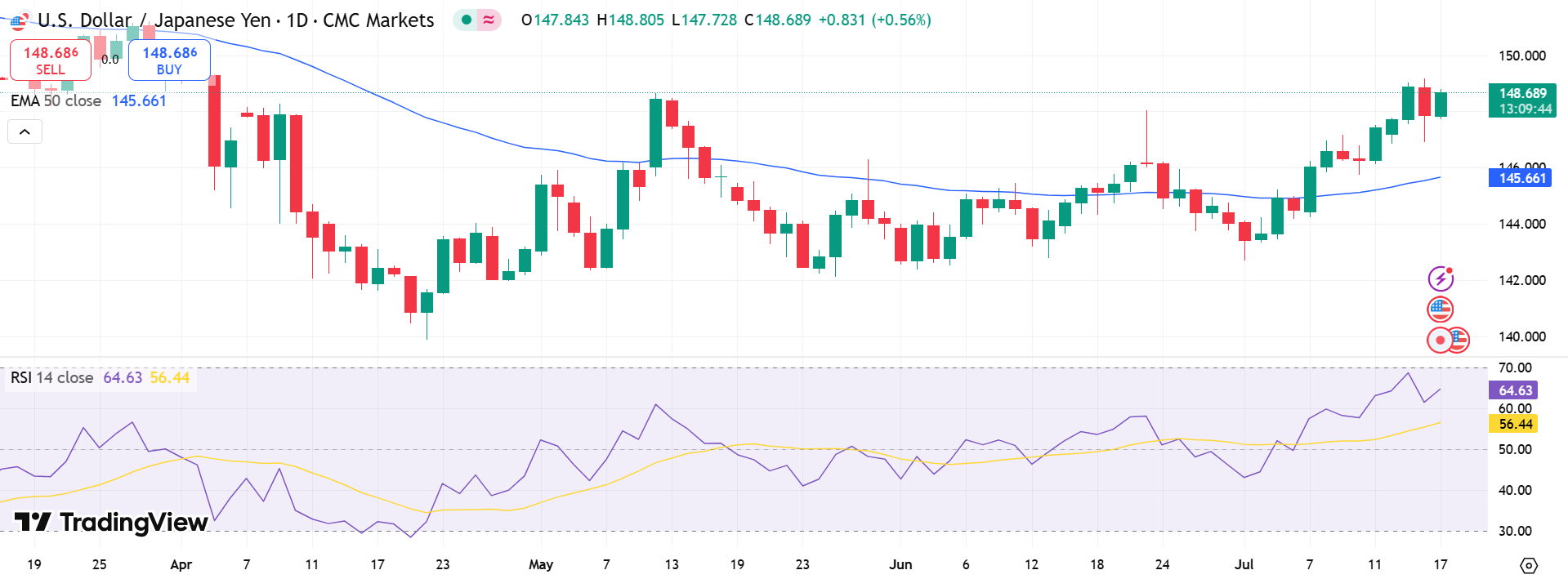The U.S. Dollar–Japanese Yen pair hovered below the 149.00 mark in Wednesday’s European session, unable to extend its gains after touching a three-week high. Investors are holding back ahead of the U.S. Producer Price Index (PPI) report due later in the day, a key input for assessing future Federal Reserve policy.
The pair remains technically bullish following a breakout above 148.00, with the next hurdle located around 149.35–149.40. However, overbought RSI levels near 70 suggest a short-term consolidation or mild pullback could be imminent. Initial support is seen at 148.65, with stronger footing at 148.00 and the 147.55–147.60 zone.
Upside potential remains intact if the pair breaks and holds above 149.00, potentially targeting the psychological 150.00 level, which has capped rallies in recent months.
U.S. Inflation Data Shapes Fed Outlook
The dollar’s latest surge has been underpinned by robust inflation data. The Consumer Price Index (CPI) for June rose 0.3% month-over-month, while the annual rate accelerated to 2.7%, up from 2.4% in May. Core CPI climbed to 2.9%, its highest level since early 2024.
These figures have dampened expectations of a near-term Fed rate cut. Yields on U.S. Treasurys climbed sharply, reflecting market bets that the central bank will maintain its policy rate in the 4.25%–4.50% range through the summer.
Key Fed signals this week:
- Boston Fed’s Susan Collins warned inflation may rise to 3% due to tariffs.
- Dallas Fed’s Lorie Logan cautioned against premature rate cuts, citing risks of long-term economic damage.
- Markets now await Thursday’s PPI report at 12:30 GMT, which may further shape rate expectations.
Yen Faces Pressure From Trade, Politics
The Japanese Yen remains under pressure as U.S.-Japan trade tensions intensify. President Trump’s administration is moving ahead with 25% tariffs on Japanese exports beginning August 1, after a 90-day pause expired without a trade agreement.

Compounding the pressure, Japan faces domestic political uncertainty ahead of the July 20 Upper House elections, with polls suggesting the ruling coalition may lose its majority. Slowing economic growth and weak wage data are adding to doubts over any near-term tightening by the Bank of Japan, keeping the Yen on the defensive.
Contributing factors to Yen weakness:
- Ongoing U.S. tariffs on Japanese goods
- Delayed BoJ rate hike expectations
- Sluggish inflation and wage growth
- Political uncertainty ahead of key elections
With the Fed expected to remain hawkish and Japan grappling with economic headwinds, the USD/JPY’s upward bias is likely to persist—provided inflation data continues to support the dollar’s momentum.


